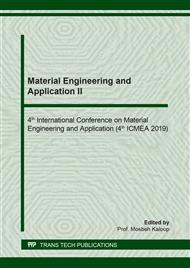[1]
F. Shukor, A. Hassan, M. S. Islam, M. Mokhtar, M. Hasan, Effect of ammonium polyphosphate on flame retardancy, thermal stability and mechanical properties of alkali treated kenaf fiber filled PLA biocomposites, Mater. Des. 54(1) (2014) 425-429.
DOI: 10.1016/j.matdes.2013.07.095
Google Scholar
[2]
L. Petersson, I. Kvien, K. Oksman, Structure and thermal properties of poly(lacticacid)/ cellulose whiskers nanocomposite materials, Compos. Sci. Techno. 67(11-12) (2007) 2535-2544.
DOI: 10.1016/j.compscitech.2006.12.012
Google Scholar
[3]
K. Oksman, M. Skrifvars, J. F. Selin, Natural fibres as reinforcement in poly lactic acid (PLA) composites, Compos. Sci. Techno. 63(9) (2003) 1317-1324.
DOI: 10.1016/s0266-3538(03)00103-9
Google Scholar
[4]
B. Bax, J. Mussig, Impact and tensile properties of PLA/Cordenka and PLA/flax composites, Compos. Sci. Techno. 68(7-8) (2008) 1601-1607.
DOI: 10.1016/j.compscitech.2008.01.004
Google Scholar
[5]
J. Ganster, H. P. Fink, M. Pinnow, High-tenacity man-made cellulose fibre reinforced thermoplastics–injection moulding compounds with polypropylene and alternative matrices, Comp. Part A: Appl. Sci. Manufac. 37(10) (2006) 1796-1804.
DOI: 10.1016/j.compositesa.2005.09.005
Google Scholar
[6]
M.A. Sawpan, K.L. Pickering, A. Fernyhough, Hemp fibre reinforced poly (lactic acid) composites, Adv. Mater. Res. 29-30(4) (2007) 337-340.
DOI: 10.4028/www.scientific.net/amr.29-30.337
Google Scholar
[7]
S.V. Lomov, A Willems, I. Verpoes, Y. Zhu, M. Barburski, T. Stoilova, Picture frame test of woven composite reinforcements with a full-field strain registration, Text. Res. J. 76(3) (2006) 243-252.
DOI: 10.1177/0040517506061032
Google Scholar
[8]
E. Bodros, I. Pillin, N. Montrelay, C. Baley, Could biopolymers reinforced by randomly scattered flax fibre be used in structural applications, Compos. Sci. Tech. 67(3-4) (2007) 462-470.
DOI: 10.1016/j.compscitech.2006.08.024
Google Scholar
[9]
E. Nassiopoulos, J. Njuguna, Thermo-mechanical performance of poly (lactic acid)/flax fibre-reinforced biocomposites, Mater. Des. 66(B) (2015) 473-485.
DOI: 10.1016/j.matdes.2014.07.051
Google Scholar
[10]
G.W. Beckermann, K.L. Pickering, Engineering and evaluation of hemp fibre reinforced polypropylene composites: fibre treatment and matrix modification, Comp Part A: Appl. Sci. Manufa. 39(6) (2008) 979-988.
DOI: 10.1016/j.compositesa.2008.03.010
Google Scholar
[11]
M. Bera, R. Alagirusamy, A. Das, A study on interfacial properties of jute-PP composites, J. Reinf. Plast. Compos. 29(20) (2010) 3155-3161.
DOI: 10.1177/0731684410369723
Google Scholar


